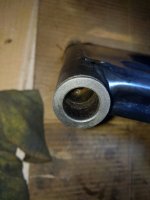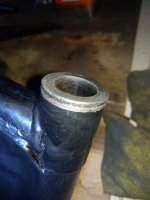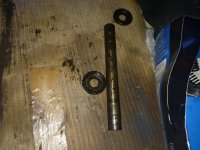highboy_coupe
XS650 Addict
Hi, I went to put in my new swingarm bearings, and after cleaning up the swingarm a bit, I am not sure what bushes I have got here, could do with some advice on what they are and how to remove them of you don't mind.
They looked to be dark coloured metal, after a scrub the bushes look dull, not very bronzey...
There are NO grease channels cut into them, and the dust caps were half tin, half rubber.
There was an inner tube, rusty, probably original.



Any tips on removing them, if they are bronze, can I grab the lip in a vice and twist the swingarm?
Thanks
They looked to be dark coloured metal, after a scrub the bushes look dull, not very bronzey...
There are NO grease channels cut into them, and the dust caps were half tin, half rubber.
There was an inner tube, rusty, probably original.



Any tips on removing them, if they are bronze, can I grab the lip in a vice and twist the swingarm?
Thanks
